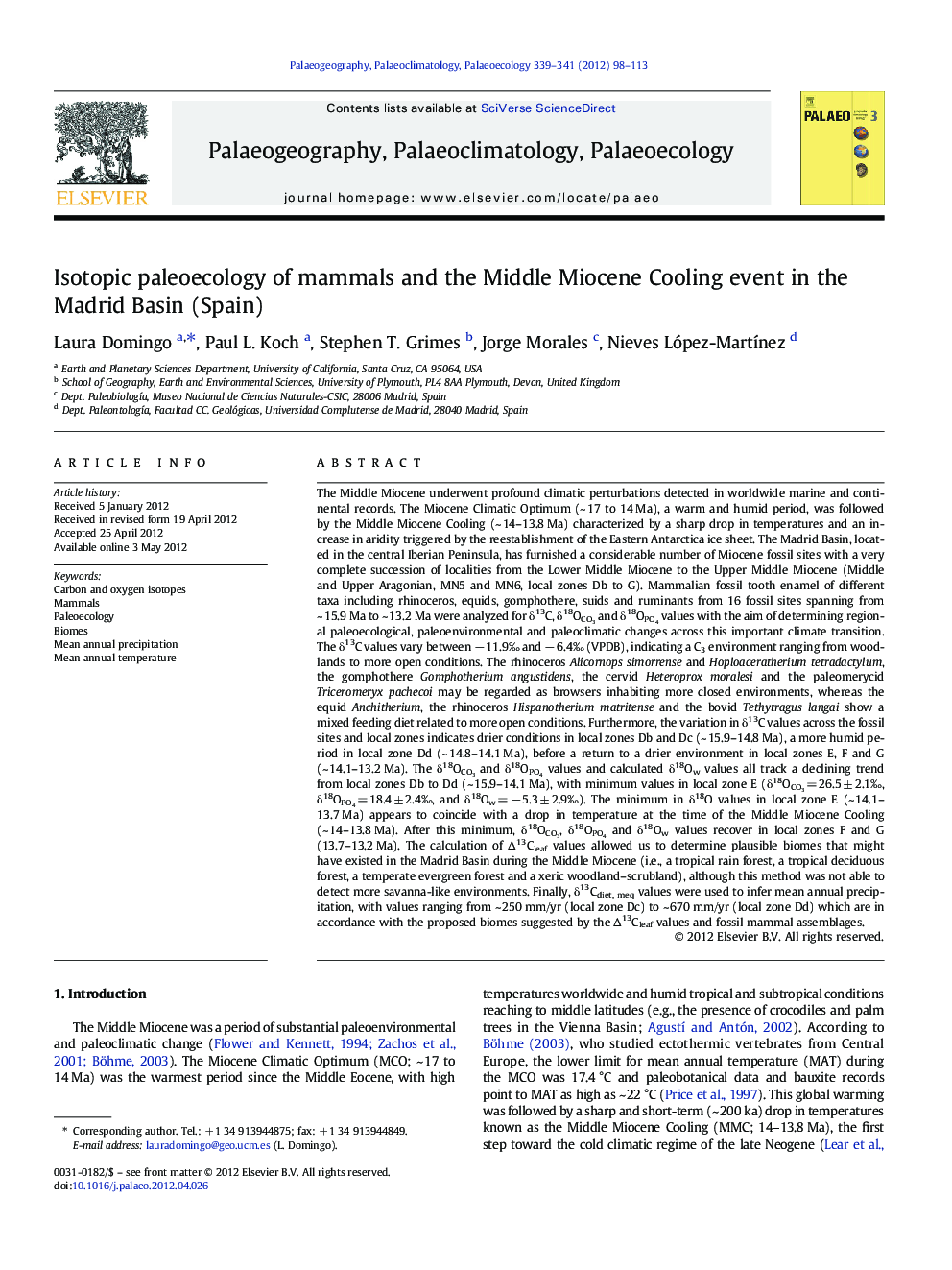| کد مقاله | کد نشریه | سال انتشار | مقاله انگلیسی | نسخه تمام متن |
|---|---|---|---|---|
| 4466884 | 1622230 | 2012 | 16 صفحه PDF | دانلود رایگان |

The Middle Miocene underwent profound climatic perturbations detected in worldwide marine and continental records. The Miocene Climatic Optimum (~ 17 to 14 Ma), a warm and humid period, was followed by the Middle Miocene Cooling (~ 14–13.8 Ma) characterized by a sharp drop in temperatures and an increase in aridity triggered by the reestablishment of the Eastern Antarctica ice sheet. The Madrid Basin, located in the central Iberian Peninsula, has furnished a considerable number of Miocene fossil sites with a very complete succession of localities from the Lower Middle Miocene to the Upper Middle Miocene (Middle and Upper Aragonian, MN5 and MN6, local zones Db to G). Mammalian fossil tooth enamel of different taxa including rhinoceros, equids, gomphothere, suids and ruminants from 16 fossil sites spanning from ~ 15.9 Ma to ~ 13.2 Ma were analyzed for δ13C, δ18OCO3 and δ18OPO4 values with the aim of determining regional paleoecological, paleoenvironmental and paleoclimatic changes across this important climate transition. The δ13C values vary between − 11.9‰ and − 6.4‰ (VPDB), indicating a C3 environment ranging from woodlands to more open conditions. The rhinoceros Alicornops simorrense and Hoploaceratherium tetradactylum, the gomphothere Gomphotherium angustidens, the cervid Heteroprox moralesi and the paleomerycid Triceromeryx pachecoi may be regarded as browsers inhabiting more closed environments, whereas the equid Anchitherium, the rhinoceros Hispanotherium matritense and the bovid Tethytragus langai show a mixed feeding diet related to more open conditions. Furthermore, the variation in δ13C values across the fossil sites and local zones indicates drier conditions in local zones Db and Dc (~ 15.9–14.8 Ma), a more humid period in local zone Dd (~ 14.8–14.1 Ma), before a return to a drier environment in local zones E, F and G (~ 14.1–13.2 Ma). The δ18OCO3 and δ18OPO4 values and calculated δ18Ow values all track a declining trend from local zones Db to Dd (~ 15.9–14.1 Ma), with minimum values in local zone E (δ18OCO3 = 26.5 ± 2.1‰, δ18OPO4 = 18.4 ± 2.4‰, and δ18Ow = − 5.3 ± 2.9‰). The minimum in δ18O values in local zone E (~ 14.1–13.7 Ma) appears to coincide with a drop in temperature at the time of the Middle Miocene Cooling (~ 14–13.8 Ma). After this minimum, δ18OCO3, δ18OPO4 and δ18Ow values recover in local zones F and G (13.7–13.2 Ma). The calculation of Δ13Cleaf values allowed us to determine plausible biomes that might have existed in the Madrid Basin during the Middle Miocene (i.e., a tropical rain forest, a tropical deciduous forest, a temperate evergreen forest and a xeric woodland–scrubland), although this method was not able to detect more savanna-like environments. Finally, δ13Cdiet, meq values were used to infer mean annual precipitation, with values ranging from ~ 250 mm/yr (local zone Dc) to ~ 670 mm/yr (local zone Dd) which are in accordance with the proposed biomes suggested by the Δ13Cleaf values and fossil mammal assemblages.
► Mid-Miocene Madrid mammal enamel analyzed for stable isotopes for the first time.
► δ13C values vary between − 11.9‰ and − 6.4‰ (VPDB), indicating a C3 environment.
► Niche partitioning observed among mammals from 16 localities from the Madrid Basin.
► δ13C values show a more humid period at ~ 14.8–14.1 Ma.
► A minimum in δ18O values at ~ 14.1–13.7 Ma coincides with the Mid-Miocene Cooling.
Journal: Palaeogeography, Palaeoclimatology, Palaeoecology - Volumes 339–341, 1 July 2012, Pages 98–113